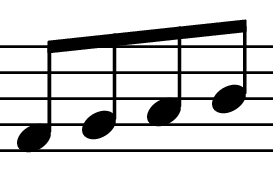| Eighth note run (Photo credit: Wikipedia) |
Continuing with a good article from Dr. Damani Phillips who currently serves as assistant professor of Jazz Studies and African-American Studies at the University of Iowa. If you missed the first part, you can see it, here.
Unlocking the Power of the Triplet
The Process
Step 2: Once comfort in developing a consistent and harmonically accurate quarter note line is demonstrated, move on to constructing the same type of line in running eighth notes. Remember, no deviation from the eighth note rhythm or stylizing of notes (scoops, bends, articulations, etc.) is permitted.
Play them as single notes.
Play them as single notes.
D7 = D, F#, A, B / C, F#, D, G
Gmaj7 = F#, B, D, C / B, G, D, F#
Gmaj7 = G, Eb, D, C / B, D, G, F#
Step 3: Once you have a comfortable grasp of those rhythms that we would expect to see/hear in simple meter, move on to quarter note triplets. As is customary in the use of this rhythm, begin by phrasing the triplets in groups of threes. Take care in avoiding the natural inclination to place a heavy accent on the first note of each triplet group. You want to preserve the linear integrity of the line's construction, and heavy accenting of these notes will make each of the phrased groups together than one long linear phrase. Use this step in the process to help truly acclimate yourself to the sound and feel of the quarter note triplet. Playing 6 over 4 can initially be awkward for some, so work to help yourself find a balance between the use of their mathematical, aural, and tactile sensibilities in developing a comfortable relationship with this rhythm.
Am7 = A, C, E / B, A, G
D7 = F#, D, E / A, F#, B
Gmaj7 = F#, A, E / F#, B, D
Gmaj7 = B, C, B / D, B, G
Step 4: Once comfortable with phrasing in groups of 3's, move on to phrasing the quarter note triplets in groups of 2's. Light accenting of the first note of each group should be applied to bring out the 3 over 4 polyrhythm created by the phrasing used, and should be executed with the use of legato tonguing ("du," not "tu" or "ta").
Am7 = E, C, B / D, C, E
D7 = B, A, E / D, F#, C
Gmaj7 = F#, D, B / G, E, C
Gmaj7 = A, F#, D / B, C, G#
Step 5: Now, extend the phrasing of the triplets to groups of 4, which generates metrical dissonance that carries over the bar line in mm. 1 and 3, but resolves itself every 2 measures. Again, light accenting of the first note of each group is necessary to bring out the implied 3 over 8 polyrhythm generated by this phrasing pattern.
Am7 = G, E, C / A, E, G
D7 = F#, D, E / C, A, F#
Gmaj7 = A, F#, G / B, D, F#
Gmaj7 = B, F#, A / G, F, D
Step 6: Once comfort is demonstrated in phrasing the triplets in the fixed numbers outlined above, explore the possibilities afforded tot he improviser when phrasing the triplets in random groups of twos, threes, or fours. In an effort to counter the randomness of the pattern used, the use of a slightly heavier accent is acceptable as a means of giving each grouping clearer aural definition. This approach has the potential to generate an infinite number of possible phrased triplet combinations that both stay within and run across the barline, representing a significant expansion of options for the improviser. In this step, the selection of triplet phrase groupings itself becomes a part of the improviser's creative process. Here is an example of the application of this concept:
Am7 = B, A, C / E, G, B
D7 = A, E, F / F#, B, A
Gmaj7 = G, F#, F / D, D, G
Gmaj7 = A, B, C / D, G, B
Further Consideration:
The approach to manipulating the quarter note triplet discussed in this article can be applied to the phrasing of both half note and eighth note triplets, depending on factors such as song tempo, the performer's technical ability and the rhythmic sensibilities of the improviser. The examples provided here are only the first phase in the exploration of the potential of the triplet. The introduction of rests in strategic places further broadens the palette of options available to the improviser. Here's a sneak peek at one effective option that this approach can generate:
Am7 = A, rest, A / B, C, rest
D7 = C, G, F# / rest, F, A
Gmaj7 = D, rest, F# / A, B, rest
Gmaj7 = G, F#, D / rest, B, D
While the procedure discussed here may seem somewhat formulaic, the real value of this approach is found in taking this concept a step further by bending the rules outlined above. While the literal application of the exercises outlined here should generate a host of new ideas for the improviser to work with, the true "hipness" of this concept is unleashed in learning to seamlessly shift between triplet-based ideas and those based in the quarters and eighths that one would expect to see/hear in simple meter. If you choose to explore this concept further, a new world of possibilities awaits the inquisitive improviser.
You may be interested in, GospelKeys Urban Pro 600
"The beautiful thing about learning is that no one can take it away from you." B.B.King















![Validate my Atom 1.0 feed [Valid Atom 1.0]](valid-atom.png)








No comments:
Post a Comment